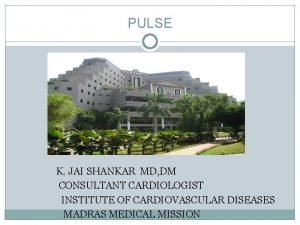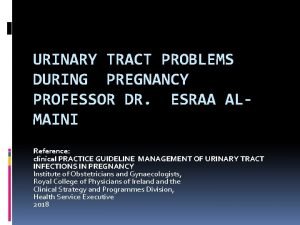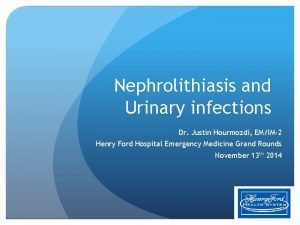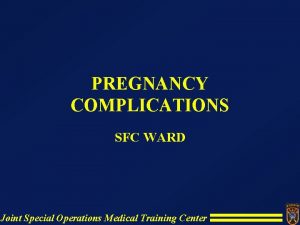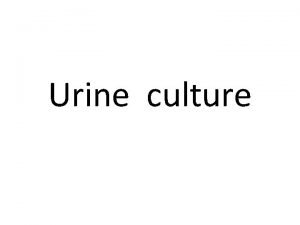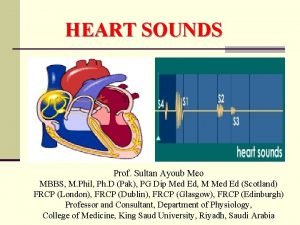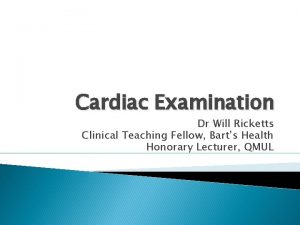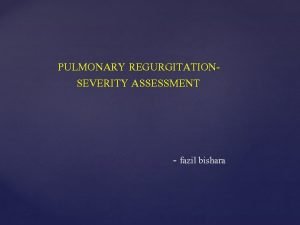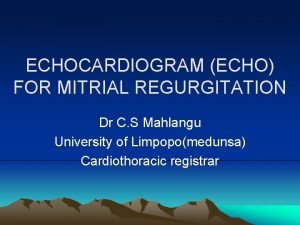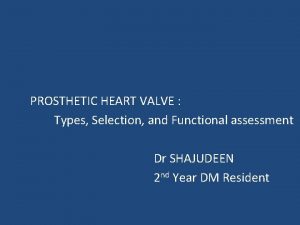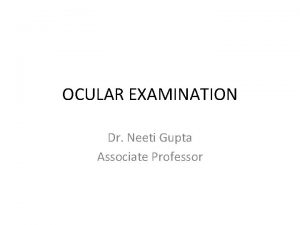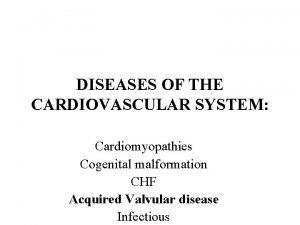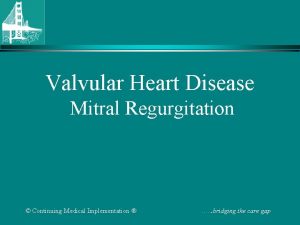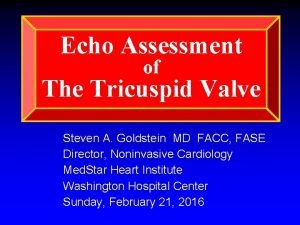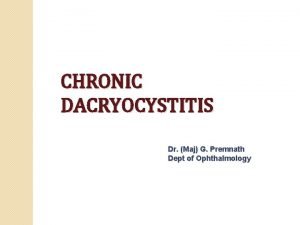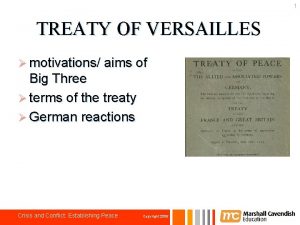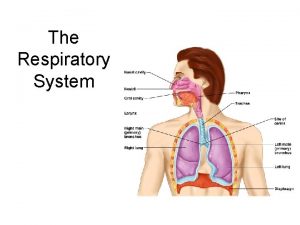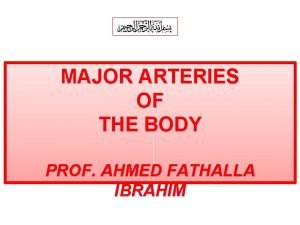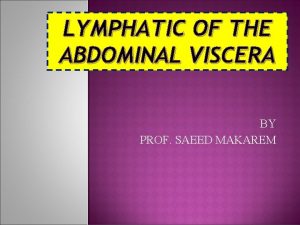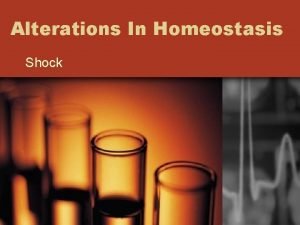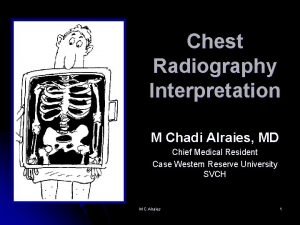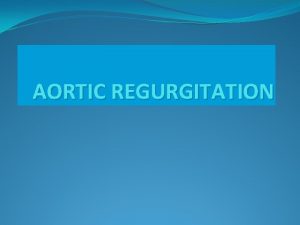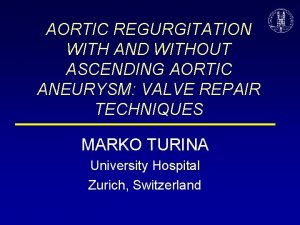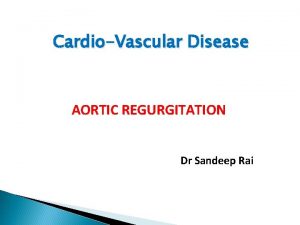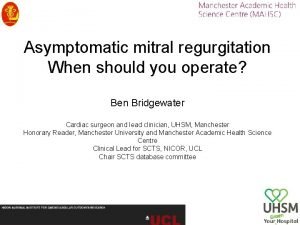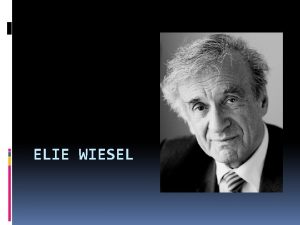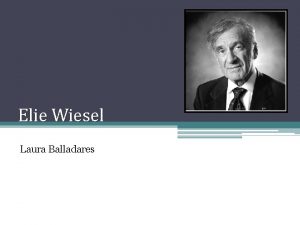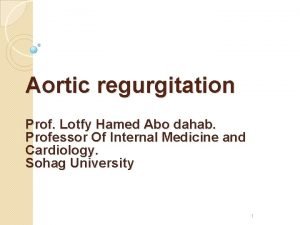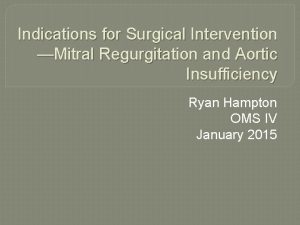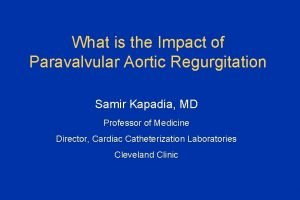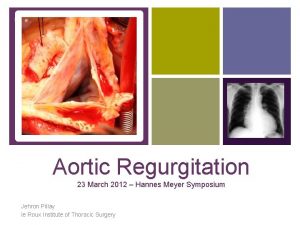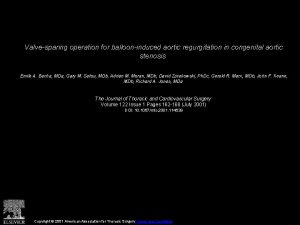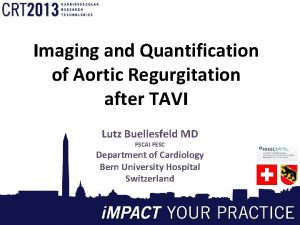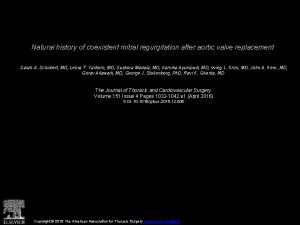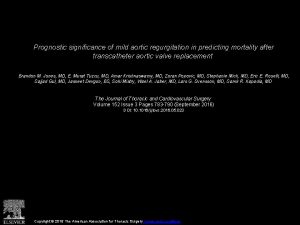Asymptomatic Aortic Regurgitation Elie Chammas MD FESC Clemenceau





























- Slides: 29

Asymptomatic Aortic Regurgitation Elie Chammas, MD. FESC Clemenceau Medical Center & Lebanese University

Introduction • Despite Significant Volume and Pressure Overload on the Left Ventricle (LV), patients with Aortic Regurgitation (AR) Typically Remain Asymptomatic For Extended Periods of Time. • Symptoms of Dyspnea, Orthopnea, Nocturnal angina and Syncope Develop Relatively Late in the Course of the Disease. • Aortic Valve Replacement (AVR) has Clearly been Shown to Prolong Survival and Improve Functional Class in Patients (Pts) with Severe Symptoms. • The Optimal Timing for Valve Replacement in Asymptomatic Pts is Less Concrete. • Should Prophylactic AVR be Performed to Preserve LV Contractile Function ? • The Benefits of Preserving Contractile Function must be Weighted against the Immediate Operative Risks Associated with Prosthetic Valves.

Natural History of Medically Treated Patients • Long asymptomatic phase, Followed by by a symptomatic phase with a relatively rapid progressive deterioration in clinical function. • Asymptomatic Patients with normal LV pump function have an excellent long-term prognosis : 90% of pts are Asymptomatic at 3 years, 81% at 5 years and 75% at 7 years. The percentage of Pts requiring AVR was < 4% per year. • Asymptomatic Patients with impaired LV ejection performance: 66 % require surgery within 3 years. • Vasodilator Therapy (nifedipine, ACE Inh), reduces LV dilatation in Asymptomatic Pts with AR who have normal LV systolic function, delaying the need for AVR • Symptomatic Pts have a poor prognosis under medical TT (4% of survival after 10 y FU, NYHA III-IV.

Natural History of Surgically Treated Patients • No randomized trials comparing Medical therapy with Surgery. • Surgical Intervention appears to improve survival and functional class in patients with AR. • LV pump function improves after aortic valve replacement with correction of the volume after load.

Indices of LV performance in Asymptomatic patients with AR • 1) Ejection Phase Indices: Asymptomatic Pts with normal LV function have an excellent long-term survival rate, and < 4% of pts per year require AVR. Asymptomatic pts with impaired LV function, have a considerably more aggressive clinical course and should be referred for elective AVR to avoid progression to irreversible contractile dysfunction. • 2) End-Systolic Dimension: 1) 80% of asymptomatic pts with an end-systolic dimension > 55 mm required surgery within 34 months compared with 20% of pts with an endsystolic dimension < 55 mm. 2) No pt with an end-diastolic dimension <= 40 mm required aortic valve replacement at 4 years, whereas 65% of pts with an end-systolic dimension >= 50 mm required surgery within the follow up period

International Guidelines

European Guidelines

Guidelines on the Management of Valvular Heart Disease ESC 2007 Guidelines • Asymptomatic Patients with Severe Aortic Regurgitation: LVEF <= 50 % or EDD > 70 mm or ESD > 50 mm (or 25 mm/m 2 BSA) No : Follow up Yes : Surgery A Vahanian, European Heart Journal 2007, 28, 230 -268

American Guidelines

Management strategy for patients with chronic severe aortic regurgitation ACC/AHA Guidelines 2006 Bonow, R. O. et al. J Am Coll Cardiol 2006; 48: e 1 -e 148 Copyright © 2006 American College of Cardiology Foundation. Restrictions may apply.

Recommendations Françaises

Recommendations de la Société Française de Cardiologie sur la prise en charge des Valvulopathies. (C Tribouilloy Archives des Maladies du Coeur 98, 2, Fev 2005) Indications Opératoires dans les Insuffisances Aortiques Chroniques Asymptomatiques. 1) Indications Formelles: a. IA volumineuse avec dysfonction du VG : DTS du VG > 25 mm/m 2 (ou > 50 mm) et / ou FE < 50% b. IA avec dilatation de l’aorte ascendante (Diamètre maximal > 55 mm) 2) Indications Admises: a. IA du syndrome de Marfan ou bicuspidie avec dilatation de l’aorte Ascendante (Diamètre maximal > 55 mm), surtout si progression rapide de ce diamètre au cours du suivi ou si antécédants familiaux de dissection aortique b. IA volumineuse et indication d’une autre intervention de chirurgie cardiaque 3) Indications Discutées: a. IA volumineuse avec dilatation du VG importante (DTD du VG > 70 mm) ou FE comprise entre 50 et 55% b. IA du syndrome de Marfan ou bicuspidie avec diamètre aortique compris entre 45 et 50 mm, en fonction des possibilités de chirurgie conservatrice , de la notion d’évolutivité, de l’âge et de la stature. c. IA du syndrome de Marfan et désir de grossesse si diamètre de l’aorte ascendante > 40 mm d. IA de sévérité moyenne et indication d’une chirurgie cardiaque associée

Recommendations de la Société Française de Cardiologie sur la prise en charge des Valvulopathies. (C Tribouilloy Archives des Maladies du Coeur 98, 2, Fev 2005) Traitement Médical dans les Insuffisances Aortiques Chroniques Asymptomatiques 1) Traitement vasodilatateur: La Nifédipine a un effet favorable sur les diamètres et la FE du VG, et permet de retarder l’heure de la chirurgie. Les IEC semblent entraîner une diminution de la fraction de régurgitation, de la masse et des volumes du VG. Les vasodilatateurs (IEC / Nifédipine ) ne sont pas recommendées en présence d’une IA modérée sans dysfonction VG ni HTA associée. Ils trouvent leur place: pour retarder la chirurgie chez les patients asymptomatiques ayant une IA volumineuse dont le diamètre télésystolique est inférieur a 25 mm/m 2 et la FE du VG supérieure à 55%. 2) Traitement B-bloquant Les BB sont indiqués quand l’IA n’est pas sévère pour prévenir la dissection aortique dans le syndrome de Marfan


Algorithm for the Timing of Surgery in Asymptomatic Pts with Aortic Regurgitation

Algorithm for the Timing of Surgery in Asymptomatic Pts with Aortic Regurgitation LV Function LV Size Points Clinical Ejection Fraction (%) End Systolic Dimension (mm) Exercise Capacity 0 None > 60% < 45 Preserved 1 1 50 -60% 45 -55 2 2 or more < 50% > 55 Decreased Clinical: Age > 65, Cardiothoracic ratio >= 0, 58, LVH on ECG, Cardiac index <=2. 5 l/m/m 2, LV ED Pressure > 20 mm. Hg. Exercise Capacity: 8 METS on graded exercise treadmill

Algorithm for the Timing of Surgery in Asymptomatic Pts with Aortic Regurgitation Total Points Decision Regarding Surgical Intervention 0 -1 Delay Surgery; Clinical and Echocardiographic follow-up at 12 mo 2 Borderline; Recommend Clinical and Echocardiographic follow-up at 6 mo >=3 Proceed with Surgery.

Algorithm for the Timing of Surgery in Asymptomatic Pts with Aortic Regurgitation (Part C) Additional Predictors of Adverse Outcome in Aortic Regurgitation Percentage Fractional Shortening < 29% End-Systolic Volume Index > 60 ml/m 2 End-Systolic Wall Stress > 235 mm. Hg End-Diastolic Dimension > 80 mm End-Diastolic Dimension (Radius) R End-Diastolic Wall Thickness Th >= 3, 2

Clinical Case • 45 y old man, construction worker, Addressed for echo : systolic and diastolic murmur • Symptoms: No Symptoms • Echo: Ejection Fraction : 55%, the LV endsystolic dimension measured 45 mm, Bicuspid Aortic valve with grade III aortic regurgitation. • Stress test: Complete stage III of a Bruce protocol Without symptoms.

Clinical Case What to do ? • • • 1. No Treatment, Only prophylaxis. 2. Medical Treatment (Nifedipine) 3. Surgical Treatment (AVR) 4. I Need more Data (TEE…) 5. I Don’t know.

Algorithm for the Timing of Surgery in Asymptomatic Pts with Aortic Regurgitation LV Function LV Size Points Clinical Ejection Fraction (%) End Systolic Dimension (mm) Exercise Capacity 0 None > 60% < 45 Preserved 1 1 50 -60% 45 -55 2 2 or more < 50% > 55 Decreased Clinical: Age > 65, Cardiothoracic ratio >= 0, 58, LVH on ECG, Cardiac index <=2. 5 l/m/m 2, LV ED Pressure > 20 mm. Hg. Exercise Capacity: 8 METS on graded exercise treadmill

Algorithm for the Timing of Surgery in Asymptomatic Pts with Aortic Regurgitation Total Points Decision Regarding Surgical Intervention 0 -1 Delay Surgery; Clinical and Echocardiographic follow-up at 12 mo 2 Borderline; Recommend Clinical and Echocardiographic follow-up at 6 mo >=3 Proceed with Surgery.

Clinical Case What to do ? • According to the Algorithm, the patient would be assigned Two points, Justifying medical therapy with serial clinical and echocardiographic follow-up. • The patient was treated with Nifedipine and followed every 6 months for 1 year, and then yearly thereafter. • At 5 years after the initial diagnosis, although the patient remained Asymptomatic, Echocardiography revealed an increase in the end-systolic dimension to 55 mm and a decrease in the Ejection Fraction to 48%, resulting in a total of Three points. • The patient was then referred for successful aortic valve replacement.

What about Patients with Aortic Regurgitation and LV dysfunction ?

Improved outcomes after aortic valve surgery for chronic aortic regurgitation with severe left ventricular dysfunction Bhudia SK, Mc. Carthy PM, Kumpari GS J Am Coll Cardiol 2007; 49: 1465 -71

Improved outcomes after aortic valve surgery for chronic aortic regurgitation with severe left ventricular dysfunction • Background: Patients with chronic AR and severe LVD have been considered high risk for aortic valve surgery, with limited prognosis. Transplantation is considered for some. (How to manage patients with severe left ventricular dysfunction and valvular regurgitation. Acar J, Michel PL, Luxereau P. J Heart Valve Dis 1996; 5: 421 -9) • Methods: 724 Pts underwent surgery for chronic AR, 12% had severe LVD. They were propensity matched to patients with non severe LVD to compare hospital mortality and late survival. • Results: Survival was lower (p=0. 04. 91% vs 96%, 30 D) among patients with severe LVD than among matched patients with non severe LVD. However, survival of Pts with severe LVD improved dramatically across the study time frame (p=0. 0004) • Conclusion: Neutralizing risk of severe LVD has improved early and late survival such that aortic valve surgery for chronic AR and cardiomyopathy is no longer a high-risk procedure for which transplantation is the best option.

Conclusion • After a long Asymptomatic period, Severe Aortic Regurgitation eventually lead to reduced LV pump performance. • The development of irreversible contractile dysfunction is associated with increased risk for post operative LV pump failure and death from congestive heart failure. • To justify the risk of surgery, the ideal timing for surgical intervention in patients with aortic regurgitation is therefore at the onset of contractile dysfunction, yet early enough to prevent the development of irreversible contractile dysfunction.

Conclusion • Echocardiography in conjunction with a thorough history and physical examination, provides accurate, reproducible, and cost-effective methodology for the serial assessment of contractile dysfunction in patients with aortic regurgitation. • The use of guidelines and the development of algorithms for timing of surgery in patients with aortic regurgitation guide operative intervention to preserve contractile function, thereby improving long-term post operative outcome and minimizing unnecessary risk.

Thank You
 Aortic regurgitation murmur
Aortic regurgitation murmur Dicrotic pulse
Dicrotic pulse Asymptomatic bacteriuria
Asymptomatic bacteriuria Asymptomatic bacteriuria
Asymptomatic bacteriuria What causes miscarriage
What causes miscarriage Asymptomatic hyperglycemia
Asymptomatic hyperglycemia Asymptomatic bacteriuria
Asymptomatic bacteriuria Suprapubic aspiration
Suprapubic aspiration Asymptomatic bacteriuria
Asymptomatic bacteriuria Triluminate pivotal trial
Triluminate pivotal trial Heart sound
Heart sound Left parasternal heave
Left parasternal heave Jet fazil
Jet fazil Mitrial
Mitrial Physiological regurgitation
Physiological regurgitation Chemosis
Chemosis Tricuspid regurgitation
Tricuspid regurgitation Pathophysiology of valvular heart disease
Pathophysiology of valvular heart disease Tricuspid valve leaflets tee
Tricuspid valve leaflets tee Chronic dacryocystitis
Chronic dacryocystitis Clemencau the vampire
Clemencau the vampire Wilson bismarck clemenceau orlando
Wilson bismarck clemenceau orlando What were the aims of the big three
What were the aims of the big three True vocal cord
True vocal cord Brachial pulse
Brachial pulse Parts of the heart diagram
Parts of the heart diagram Cisterna chyli
Cisterna chyli Aortic stanosis
Aortic stanosis X-ray
X-ray Rete testis
Rete testis

